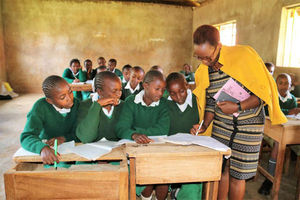
President William Ruto receives the instruments of power from his predecessor Uhuru Kenyatta after he took the oath of office at Moi International Sports Center, Kasarani on September 13, 2022.
In the eternal dance of shifting Kenyan political alliances, on December 9, President William Ruto stunned nearly everyone by heading to the village home of his erstwhile bosom ally, turned bitter political foe, former President Uhuru Kenyatta, bearing 12 goats as a peace offering.
Ruto was Kenyatta’s deputy from 2013 until 2022. Still, they fell out and became ensnared in an acrimonious relationship after the 2017 election, following Kenyatta's decision to bury the hatchet with opposition leader Raila Odinga. Come the 2022 election, the two went their separate ways, with Kenyatta backing Raila against Ruto for the presidency.
With the Ruto administration maintaining a hostile stance against Kenyatta, and the latter’s family farm looted by pro-government supporters in 2023, with his mother and children harassed, it was considered impossible that the two would ever share the same air in a room again. On the other hand, for Raila, a man with a history of political pragmatism, a future accommodation was considered hard, but not impossible.
When Ruto and Raila reconciled earlier in the year, there wasn’t much disbelief. In quick order, Raila announced his candidacy for chairperson of the African Union Commission, and Ruto has unleashed all the treasure and diplomatic capital he can muster for Raila’s quest. The apparent rapprochement with Kenyatta, however, still has many baffled or in disbelief.
Slippery political ground
Following the recent nasty impeachment of Ruto’s deputy Rigathi Gachagua—who deeply disliked Kenyatta, once an ally—some speculate that the President feels he’s on very slippery political ground in the latter’s vote-rich Central Kenya region, and he is trying to stem the bleeding by getting Kenyatta on his side.
However, beyond any electoral political calculations for the near future that might be at play, these events signal deeper structural problems that are bigger than the political players themselves.
For one, it seems that in contemporary Kenya, the most successful way of winning elections (with regional and ethnic alliances) has become the worst possible way to govern after victory. This is problematic, and one could argue that it is undemocratic because it means a voter mandate has largely become useless in Kenya. Secondly, the forces that stabilise the government, the “handshakes”, are outside the constitution. The defects and opportunities become clear when compared to what has happened in other countries in history.
Perhaps the most famous handshake in politics comes from 1860s America, after Abraham Lincoln, who was not a favourite by any means, won the Republican nomination for president in 1860. Lincoln ended up with a divided party, including several prominent figures who had also vied for the nomination. Lincoln became president and named virtually all of them to his government, forming the famed “Team of Rivals” immortalised by historian Doris Kearns Goodwin in her book “Team of Rivals: The Political Genius of Abraham Lincoln”, which inspired the Oscar award-winning film “Lincoln”.
In the United Kingdom, during World War II, Prime Minister Winston Churchill brought into his wartime coalition government members from different political parties, including Labour leaders like Clement Attlee, whom he picked as his deputy.
Jawaharlal Nehru, who in August 1947 became India’s first Prime Minister, included rivals in his Cabinet, notably Sardar Vallabhbhai Patel, who was a key leader in the independence movement but held differing views on several issues. Patel served as Deputy Prime Minister and Home Minister.
Political factions
In 2010 in the UK, the Conservative Party’s David Cameron formed a coalition government with the Liberal Democrats and included several members of the opposition party in his Cabinet. In Germany, the imperturbable and effective Angela Merkel included rivals in her Cabinet throughout her tenure.
In Africa, Nelson Mandela set the bar quite high. After becoming the first democratically elected black President of South Africa in 1994, Mandela famously included members from various political factions in his government of national unity. This included former adversaries like FW de Klerk from the old apartheid regime, who served as one of two Deputy Presidents.
In these cases, we see deliberate political strategies of inclusivity and national unity during crisis, and tapping talent from outside the party or dominant faction. Kenya does some of the above, but also—except after the 2007-2008 post-election violence crisis— includes neutralising opposition.
More importantly, while the assured winning strategy in Kenyan elections is getting the best social, cultural and regional cocktail, we are learning that governing requires one to get the alliance of interests, including international ones, right. And to achieve those interests, Kenya will have to build a political system based on that which the political class still fears—economic class.
The author is a journalist, writer, and curator of the "Wall of Great Africans." X (Twitter) @cobbo3










